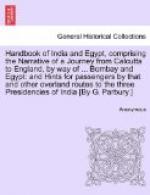His entire stock-in-trade, including the ground coffee in his kettle, does not as a rule exceed five rupees in value. The “kahwe-wala” belongs to three nationalities, Arab, Negro and Native Indian. If an Arab, he may be a disabled sailor or the retired body-servant of some Arab merchant; if an Indian, he is usually an old resident of the city, experienced in the wiles of the urban population and sometimes perhaps a protege of the local police. He has a perfect acquaintance with the intricacies of Bombay galis and back-slums; he is a creature of jovial temper, being hail-fellow-well-met with most of his customers, and he is not a grasping creditor. His account, which he notes down on whitewashed walls, sometimes reaches the sum of Rs. 10 to Rs. 15 where thriftless wives are concerned. Generally the score is paid: but if it be shirked or disputed, he never thinks of invoking legal aid for the recovery of his money. He has an abiding faith in the doctrine of “Live and let live.”
XVIII.
THE PANDU-LENA CAVES.
A NASIK PILGRIMAGE.
Nasik! What a story the name evokes! Nasik the Lotus-city, Nasik the home of Gods; who has borrowed her name from the nine hills which lay within the compass of her sacred walls. For we like not, nor do we believe, that alternative derivation of the name from “Nasika,” a nose, in allusion to the fate which here overtook the demon Shurpanakhi. It is altogether too savage an appellation for a city whose purity was established in the “Krita Yuga,” and whose fame is coeval with that of the great protagonists of Hindu myth and epic. The great city of religion in the West stood upon seven hills, the holy city of the East stood upon nine; and the famous rivers which flow past them whisper in each case of a heritage of undying renown. Fancy hand in hand perhaps with a substratum of historical truth has discovered traces of Rama’s chequered life, of Sita’s devotion in many spots within the limits of Nasik. The Forest of Austerity (Tapovan), Panchvati and Ramsej or Ram’s seat, that strangely-shaped hill fortress to the north of Nasik, are but three of the holy places which appeal so forcibly to the hearts of the people as the visible legacies of divine life on earth.
But to us the temples and the sacred pools seem nothing by comparison with the mighty monuments of Buddhism, which local wiseacres have erroneously named the Pandu-Lena or caves of the Pandavas. We drive out in the fresh morning air along the trunk road, which extends southwards of the holy city like a grey ribbon streaked by two parallel lines of lighter colour where the wheels of the bullock-carts have ground the hard metal into dust; and hard by the fifth milestone we come face to face with three stark hills, standing solitary out of the plain. A congeries of Mhars’ huts fringing the roadside marks the most convenient spot for alighting, whence we strike across the belt




